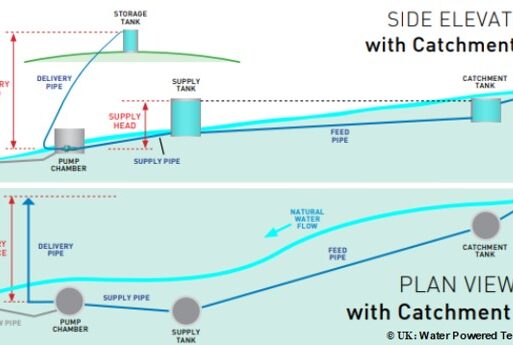Food producers need water moved from a natural flowing source to higher elevations for all sorts of reasons, and historically one way to do this was with Hydraulic Ram Pumps.
The Ram Pump offers a way to move water up-hill without electricity.
Hydraulic Ram Pumps have been around since the 1780’s, but the technology has become overlooked in the modern world of electricity. Electric submersible pumps have become the tool of choice, even where Ram Pumps makes better sense.
Let’s take a look at Ram Pump technology and see where it fits in today: The Victorians created a heavy cast iron Bell Type Ram Pump that effectively uses the energy in a mass of falling water to push up to 1/3 of that mass to a Delivery Head that is higher than the Supply Head.
It’s not magic:
Physics allows us to use energy from a falling body of water passing through the pump to push some of that water to height. Let me describe the key aspects of Ram Pumping.
First, the pump is sited lower than the water source, but the output is higher than the water source. That might seem bizarre when thinking about abstracting water from a flowing river. The trick is in fiding the right abstraction point in relation to a pump site.
Second, most of the water that flows though the pump is returned to the water course.
This is how you might configure abstraction (or catchment) and pump sites.
PapaPump: Why the new design?
Cast iron Ram Pumps are heavy, expensive to produce and ship, and because they have fallen out of favour almost all manufacturers have closed down, so spares for those pumps still in use have become difficult to get hold of.
New Generation Technology
One company has taken a diferent path, and re-invented the Ram Pump for the 21st Century to provide the first packaged solution to replace electrical submersible pumps. These new pumps can elevate up to 25000 liters a day from a relatively small stream. And if that’s not enough, they have gone one step further to produce the Venturo Ram Pump, that is an order of magnitude larger than any Ram Pump ever produced. The Venturo can deliver 6.5 million liters a day to an elevated location.
The re-invented Ram Pump uses a patented design quite different from the Victorian progentior, and is built to last. It utilises comosite material that is much cheaper for production at scale. Spare parts are transferable between pumps, freely available, and inexpensive. Reliability hasn’t been compromised either. The manufacturer tells me that they have 20+ year old installations still quietly pumping away 24/7 with no more intervention than to replace a few rubber seals every year or so.

Life Saver: Cost Saver:
Energy-less pumping has proved effective in all sorts of environments where electricity and skilled labout is in short supply. Remote villages and farms from Argentina to Zambia, and Asia to The Americas use Ram Pumps.
There’s even a project underway on the Tsavo River to daily elevate 800,000 liters of water by 227 meters, to an otherwise dry location, for the local human, elephant and other wildlife populations. All without electricity.
Being able to move water up-hill “without power” helps mitigate the staggering fact that, according to WaterAid, every 2 seconds a woman gives birth in a health centre without clean water. Getting clean water to where it’s needed provides knock-on benefits to health, education, equity and the economy. Investment in water assets yields both economic and social dividends.
Thinking outside the box:
Novel but entirely practical applications of the new-generration Ram Pumps can be found in water battery installations. Efficient Ram Pump equipment is used to re-elevate some of the exhaust turbine water reducing the energy required for the re-charging cycle. This can lead to a 30% saving in re-charging costs.
And you don’t have to aim high. The new-generation Ram Pump can deliver pressurised water at up to 20 bar. This has water purification, or other industrial applications, where pressure is more important than elevation.
Commercial – Real world applications:
The reasons to switch to Ram Pumps is clear in situations where diesel generated power is being used to pump water from a flowing or elevated source.
In practice it takes roughly 10 ltrs of diesel to lift 1000 cubic meters of water 10 meters, which at today’s prices amounts to just under $5500 pa.
That’s an unnecessary and rising hit on the bottom line, that raises the cost of production, and exacerbates the universal problem of burning fossil fuels, not to mention issues around unreliability of fuel supply, maintenance and equipment replacement costs.
In the real world though, on-site diesel generated power is used for more than just pumping water. You might feel that investigating fuel savings with Ram Pumps isn’t worth the effort because you’ve got to keep your generator running anyway, and you might be right. But consider the following:
Ram Pumps aren’t like an electric pump. They run 24/7 and deliver a volume of water based on supply head, pump size and delivery head; so you may well get more water than you need. Now, if your new Ram Pump is indeed delivering more water than you need, you can run your excess water back down to your pump and through your own hydro-generator to supliment your electricity needs. And now you have 24/7 power without diesel or batteries, plus a further reduction in your fossil fuel dependence.
One recent study in Zimbabwe, for a site that is heavily reliant on diesel to satisfy it’s enormous electricity needs, suggests savings of over $110k pa from a stream flowing at just 330 liters per second. With pay-back in under 3 years, those kind of numbers make good commercial and environmental sense.
Pressure to reduce production costs, and a real need to reduce carbon emissions make investigating any green energy solution worth while, and Ram Pumps are no exception. Site geography will determine how effective Ram Pump technology can be, but once installed it will deliver cost and environmental benefits for decades to come.
If you have access to running water, and decide to explore what Ram Pumps could do for you, it is important to have a professional eye look over your proposed installation. While the principals are simple, so are the potential mistakes, and a trained eye can mitigate errors amd help turn an installation project into a success.
Useful Links:
Water Powered Technology: https://waterpoweredtechnologies.com/
Sub-Sahara Distribution: becks@free-water.net








